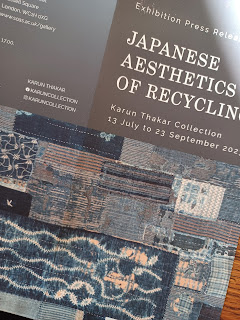This exhibition on Japanese recycling focused on textiles and paper although there were some examples of kintsugi repaired pottery. I particularly enjoyed the mended and patched Boro textiles that are shown on the press release in the image. The term Boro comes from boroboro which means something tattered or repaired and many of these pieces have numerous layers and a variety of stitches holding the fabric together. Although these clothes reflect the poverty of those who originally owned them they are beautiful items and are often a record of several members of the same family. There were also several examples of washi paper which had been recycled by layering them together to make wrapping cloths or cut into fine strips and twisted to make paper thread. One example of the use of paper thread was a type of undergarment called an asehajiki, also known as a sweat repeller, made in a lace ground of alternate four thread plaits and two thread twists, so it resembles a strig vest. A replica is being reproduced by Sian Bowen as part of a residency at Kew Gardens, which was also exhibited. There were also two examples of this type of lace in garments from the permanent collection, both worked in the same way but with just one twist between the plaits, forming a denser fabric. Unfortunately photography was not allowed. I’ve never seen examples of this type of lace in Japan before and it was not worked with any type of bobbins or thread holders – although the tangle of threads suggested it would have been easier with some!
Subscribe to:
Post Comments (Atom)


No comments:
Post a Comment